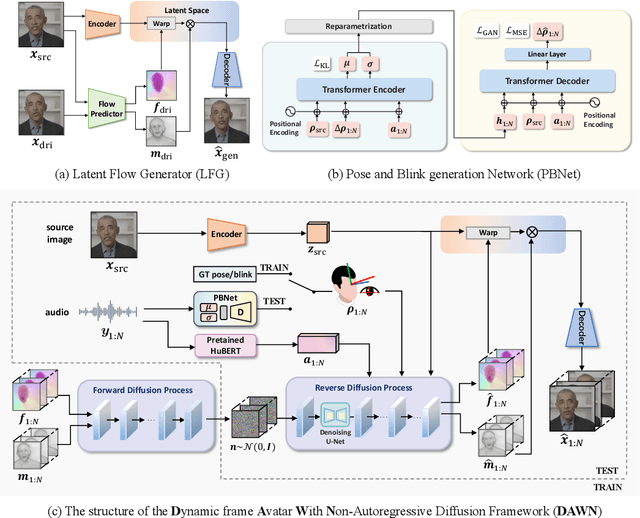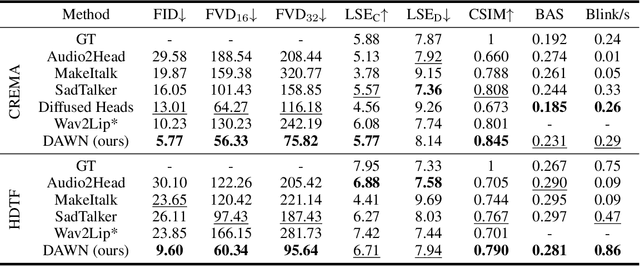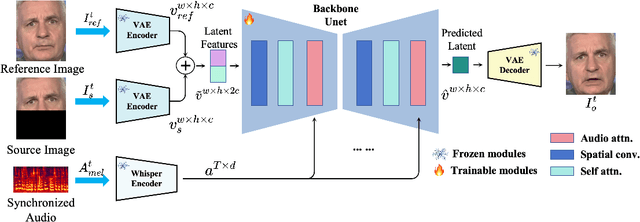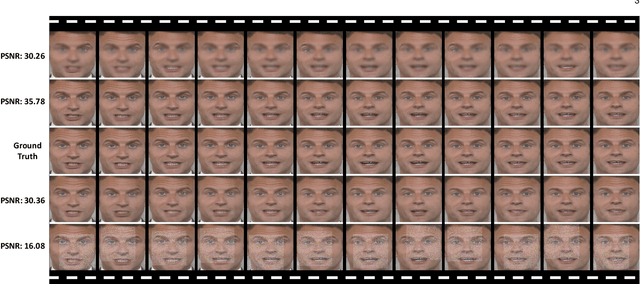Talking Head Generation
Talking head generation is the process of generating videos of a person speaking based on an audio recording of their voice.
Papers and Code
DAWN: Dynamic Frame Avatar with Non-autoregressive Diffusion Framework for Talking Head Video Generation
Oct 17, 2024



Talking head generation intends to produce vivid and realistic talking head videos from a single portrait and speech audio clip. Although significant progress has been made in diffusion-based talking head generation, almost all methods rely on autoregressive strategies, which suffer from limited context utilization beyond the current generation step, error accumulation, and slower generation speed. To address these challenges, we present DAWN (Dynamic frame Avatar With Non-autoregressive diffusion), a framework that enables all-at-once generation of dynamic-length video sequences. Specifically, it consists of two main components: (1) audio-driven holistic facial dynamics generation in the latent motion space, and (2) audio-driven head pose and blink generation. Extensive experiments demonstrate that our method generates authentic and vivid videos with precise lip motions, and natural pose/blink movements. Additionally, with a high generation speed, DAWN possesses strong extrapolation capabilities, ensuring the stable production of high-quality long videos. These results highlight the considerable promise and potential impact of DAWN in the field of talking head video generation. Furthermore, we hope that DAWN sparks further exploration of non-autoregressive approaches in diffusion models. Our code will be publicly at https://github.com/Hanbo-Cheng/DAWN-pytorch.
Beyond Fixed Topologies: Unregistered Training and Comprehensive Evaluation Metrics for 3D Talking Heads
Oct 14, 2024Generating speech-driven 3D talking heads presents numerous challenges; among those is dealing with varying mesh topologies. Existing methods require a registered setting, where all meshes share a common topology: a point-wise correspondence across all meshes the model can animate. While simplifying the problem, it limits applicability as unseen meshes must adhere to the training topology. This work presents a framework capable of animating 3D faces in arbitrary topologies, including real scanned data. Our approach relies on a model leveraging heat diffusion over meshes to overcome the fixed topology constraint. We explore two training settings: a supervised one, in which training sequences share a fixed topology within a sequence but any mesh can be animated at test time, and an unsupervised one, which allows effective training with varying mesh structures. Additionally, we highlight the limitations of current evaluation metrics and propose new metrics for better lip-syncing evaluation between speech and facial movements. Our extensive evaluation shows our approach performs favorably compared to fixed topology techniques, setting a new benchmark by offering a versatile and high-fidelity solution for 3D talking head generation.
MuseTalk: Real-Time High Quality Lip Synchronization with Latent Space Inpainting
Oct 14, 2024



Achieving high-resolution, identity consistency, and accurate lip-speech synchronization in face visual dubbing presents significant challenges, particularly for real-time applications like live video streaming. We propose MuseTalk, which generates lip-sync targets in a latent space encoded by a Variational Autoencoder, enabling high-fidelity talking face video generation with efficient inference. Specifically, we project the occluded lower half of the face image and itself as an reference into a low-dimensional latent space and use a multi-scale U-Net to fuse audio and visual features at various levels. We further propose a novel sampling strategy during training, which selects reference images with head poses closely matching the target, allowing the model to focus on precise lip movement by filtering out redundant information. Additionally, we analyze the mechanism of lip-sync loss and reveal its relationship with input information volume. Extensive experiments show that MuseTalk consistently outperforms recent state-of-the-art methods in visual fidelity and achieves comparable lip-sync accuracy. As MuseTalk supports the online generation of face at 256x256 at more than 30 FPS with negligible starting latency, it paves the way for real-time applications.
MMHead: Towards Fine-grained Multi-modal 3D Facial Animation
Oct 10, 2024



3D facial animation has attracted considerable attention due to its extensive applications in the multimedia field. Audio-driven 3D facial animation has been widely explored with promising results. However, multi-modal 3D facial animation, especially text-guided 3D facial animation is rarely explored due to the lack of multi-modal 3D facial animation dataset. To fill this gap, we first construct a large-scale multi-modal 3D facial animation dataset, MMHead, which consists of 49 hours of 3D facial motion sequences, speech audios, and rich hierarchical text annotations. Each text annotation contains abstract action and emotion descriptions, fine-grained facial and head movements (i.e., expression and head pose) descriptions, and three possible scenarios that may cause such emotion. Concretely, we integrate five public 2D portrait video datasets, and propose an automatic pipeline to 1) reconstruct 3D facial motion sequences from monocular videos; and 2) obtain hierarchical text annotations with the help of AU detection and ChatGPT. Based on the MMHead dataset, we establish benchmarks for two new tasks: text-induced 3D talking head animation and text-to-3D facial motion generation. Moreover, a simple but efficient VQ-VAE-based method named MM2Face is proposed to unify the multi-modal information and generate diverse and plausible 3D facial motions, which achieves competitive results on both benchmarks. Extensive experiments and comprehensive analysis demonstrate the significant potential of our dataset and benchmarks in promoting the development of multi-modal 3D facial animation.
Learning Frame-Wise Emotion Intensity for Audio-Driven Talking-Head Generation
Sep 29, 2024Human emotional expression is inherently dynamic, complex, and fluid, characterized by smooth transitions in intensity throughout verbal communication. However, the modeling of such intensity fluctuations has been largely overlooked by previous audio-driven talking-head generation methods, which often results in static emotional outputs. In this paper, we explore how emotion intensity fluctuates during speech, proposing a method for capturing and generating these subtle shifts for talking-head generation. Specifically, we develop a talking-head framework that is capable of generating a variety of emotions with precise control over intensity levels. This is achieved by learning a continuous emotion latent space, where emotion types are encoded within latent orientations and emotion intensity is reflected in latent norms. In addition, to capture the dynamic intensity fluctuations, we adopt an audio-to-intensity predictor by considering the speaking tone that reflects the intensity. The training signals for this predictor are obtained through our emotion-agnostic intensity pseudo-labeling method without the need of frame-wise intensity labeling. Extensive experiments and analyses validate the effectiveness of our proposed method in accurately capturing and reproducing emotion intensity fluctuations in talking-head generation, thereby significantly enhancing the expressiveness and realism of the generated outputs.
LaDTalk: Latent Denoising for Synthesizing Talking Head Videos with High Frequency Details
Oct 01, 2024



Audio-driven talking head generation is a pivotal area within film-making and Virtual Reality. Although existing methods have made significant strides following the end-to-end paradigm, they still encounter challenges in producing videos with high-frequency details due to their limited expressivity in this domain. This limitation has prompted us to explore an effective post-processing approach to synthesize photo-realistic talking head videos. Specifically, we employ a pretrained Wav2Lip model as our foundation model, leveraging its robust audio-lip alignment capabilities. Drawing on the theory of Lipschitz Continuity, we have theoretically established the noise robustness of Vector Quantised Auto Encoders (VQAEs). Our experiments further demonstrate that the high-frequency texture deficiency of the foundation model can be temporally consistently recovered by the Space-Optimised Vector Quantised Auto Encoder (SOVQAE) we introduced, thereby facilitating the creation of realistic talking head videos. We conduct experiments on both the conventional dataset and the High-Frequency TalKing head (HFTK) dataset that we curated. The results indicate that our method, LaDTalk, achieves new state-of-the-art video quality and out-of-domain lip synchronization performance.
DreamHead: Learning Spatial-Temporal Correspondence via Hierarchical Diffusion for Audio-driven Talking Head Synthesis
Sep 16, 2024Audio-driven talking head synthesis strives to generate lifelike video portraits from provided audio. The diffusion model, recognized for its superior quality and robust generalization, has been explored for this task. However, establishing a robust correspondence between temporal audio cues and corresponding spatial facial expressions with diffusion models remains a significant challenge in talking head generation. To bridge this gap, we present DreamHead, a hierarchical diffusion framework that learns spatial-temporal correspondences in talking head synthesis without compromising the model's intrinsic quality and adaptability.~DreamHead learns to predict dense facial landmarks from audios as intermediate signals to model the spatial and temporal correspondences.~Specifically, a first hierarchy of audio-to-landmark diffusion is first designed to predict temporally smooth and accurate landmark sequences given audio sequence signals. Then, a second hierarchy of landmark-to-image diffusion is further proposed to produce spatially consistent facial portrait videos, by modeling spatial correspondences between the dense facial landmark and appearance. Extensive experiments show that proposed DreamHead can effectively learn spatial-temporal consistency with the designed hierarchical diffusion and produce high-fidelity audio-driven talking head videos for multiple identities.
EMOdiffhead: Continuously Emotional Control in Talking Head Generation via Diffusion
Sep 11, 2024



The task of audio-driven portrait animation involves generating a talking head video using an identity image and an audio track of speech. While many existing approaches focus on lip synchronization and video quality, few tackle the challenge of generating emotion-driven talking head videos. The ability to control and edit emotions is essential for producing expressive and realistic animations. In response to this challenge, we propose EMOdiffhead, a novel method for emotional talking head video generation that not only enables fine-grained control of emotion categories and intensities but also enables one-shot generation. Given the FLAME 3D model's linearity in expression modeling, we utilize the DECA method to extract expression vectors, that are combined with audio to guide a diffusion model in generating videos with precise lip synchronization and rich emotional expressiveness. This approach not only enables the learning of rich facial information from emotion-irrelevant data but also facilitates the generation of emotional videos. It effectively overcomes the limitations of emotional data, such as the lack of diversity in facial and background information, and addresses the absence of emotional details in emotion-irrelevant data. Extensive experiments and user studies demonstrate that our approach achieves state-of-the-art performance compared to other emotion portrait animation methods.
StyleTalk++: A Unified Framework for Controlling the Speaking Styles of Talking Heads
Sep 14, 2024



Individuals have unique facial expression and head pose styles that reflect their personalized speaking styles. Existing one-shot talking head methods cannot capture such personalized characteristics and therefore fail to produce diverse speaking styles in the final videos. To address this challenge, we propose a one-shot style-controllable talking face generation method that can obtain speaking styles from reference speaking videos and drive the one-shot portrait to speak with the reference speaking styles and another piece of audio. Our method aims to synthesize the style-controllable coefficients of a 3D Morphable Model (3DMM), including facial expressions and head movements, in a unified framework. Specifically, the proposed framework first leverages a style encoder to extract the desired speaking styles from the reference videos and transform them into style codes. Then, the framework uses a style-aware decoder to synthesize the coefficients of 3DMM from the audio input and style codes. During decoding, our framework adopts a two-branch architecture, which generates the stylized facial expression coefficients and stylized head movement coefficients, respectively. After obtaining the coefficients of 3DMM, an image renderer renders the expression coefficients into a specific person's talking-head video. Extensive experiments demonstrate that our method generates visually authentic talking head videos with diverse speaking styles from only one portrait image and an audio clip.
DiffTED: One-shot Audio-driven TED Talk Video Generation with Diffusion-based Co-speech Gestures
Sep 11, 2024



Audio-driven talking video generation has advanced significantly, but existing methods often depend on video-to-video translation techniques and traditional generative networks like GANs and they typically generate taking heads and co-speech gestures separately, leading to less coherent outputs. Furthermore, the gestures produced by these methods often appear overly smooth or subdued, lacking in diversity, and many gesture-centric approaches do not integrate talking head generation. To address these limitations, we introduce DiffTED, a new approach for one-shot audio-driven TED-style talking video generation from a single image. Specifically, we leverage a diffusion model to generate sequences of keypoints for a Thin-Plate Spline motion model, precisely controlling the avatar's animation while ensuring temporally coherent and diverse gestures. This innovative approach utilizes classifier-free guidance, empowering the gestures to flow naturally with the audio input without relying on pre-trained classifiers. Experiments demonstrate that DiffTED generates temporally coherent talking videos with diverse co-speech gestures.
 Add to Chrome
Add to Chrome Add to Firefox
Add to Firefox Add to Edge
Add to Edge